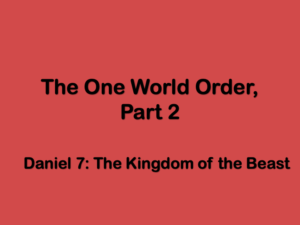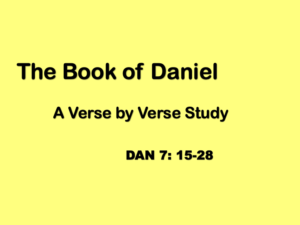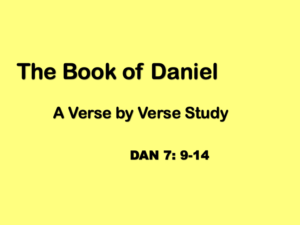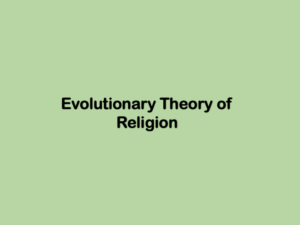Daniel 7: 13-14 The Son of Man
In verses 9-12, Daniel saw a court of judgement set up by God in which the fourth beast was judged and punished. Next a figure “like a son of man,” arrives, and is given rulership over the Kingdom of God. We know from Daniel chapter 2 that the Kingdom of God will follow the kingdoms of men, but who is the figure who is “like a son of man?”
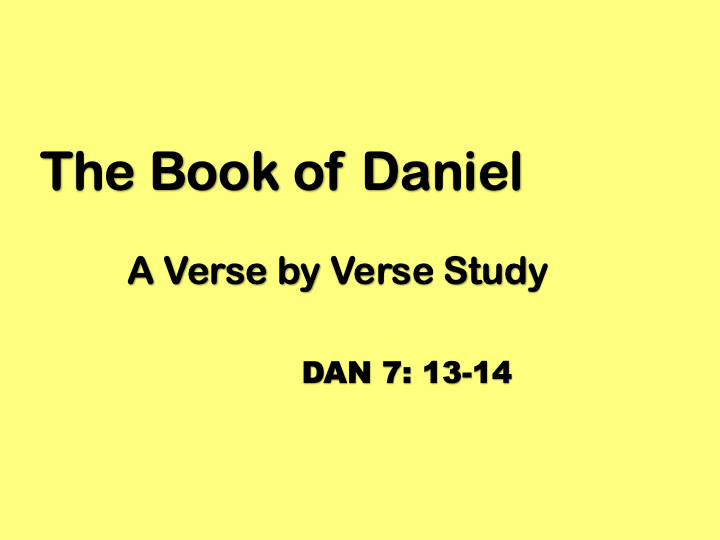
In chapter 2, Nebuchadnezzar’s dream ended with a stone destroying the kingdoms of men. Then the stone grew into a world-wide kingdom, a kingdom ruled by God. In chapter 7, we learn in Daniel’s vision that God will give the rulership of the kingdom to “one like a son of man.”
“I saw in the night visions, and behold, there came with the clouds of the sky one like a son of man, and he came even to the ancient of days, and they brought him near before him. Dominion was given him, and glory, and a kingdom, that all the peoples, nations, and languages should serve him. His dominion is an everlasting dominion, which will not pass away, and his kingdom which will not be destroyed.”
Daniel 7: 13-14
Scholars are divided on the interpretation of this passage. Conservative and evangelical scholars point to the “son of man,” as a clear reference to the messiah. Critical scholars deny this, and instead argue for differing interpretations, either the nation of Israel, or an angel.
The Son of Man
The term used in Daniel 7 is bar enas, which is Aramaic for “son of man.” The Hebrew equivalent for son of man is ben adam (adam is the Hebrew word for man). In the Old Testament, ben adam is sometimes used to describe a human. For example, God calls the prophet Ezekiel “ben adam” 93 times in the book of Ezekiel.
In Daniel chapter 7, however, the figure is not describe as a son of man, but instead as “like son a man.” This means he is similar to a human, but also different, and this phrase is usually interpreted as he has the appearance of a human. Often this phrase is used to describe an angel or other supernatural being. In Daniel’s vision, we are also told that comes “with the clouds of the sky.” In both the Old Testament and in Ancient Near Eastern literature, the “clouds of the sky” is a symbol of divinity.
In Exodus, God led the Israelites out of Egypt in the form of a cloud.
Yahweh went before them by day in a pillar of cloud, to lead them on their way, and by night in a pillar of fire, to give them light, that they might go by day and by night: the pillar of cloud
By day and the pillar of fire by night, didn’t depart from before the people.
Exodus 13: 21-22
Later in Exodus, God descends on mount Sinai in the form of a cloud.
Moses went up on the mountain, and the cloud covered the mountain. Yahweh’s glory settled on Mount Sinai, and the cloud covered it six days. The seventh day he called to Moses out of the middle of the cloud. The appearance of Yahweh’s glory was like the devouring fire on top of the mountain in the eyes of the children of Israel. Moses entered into the middle of the cloud, and went up on the mountain; and Moses was on the mountain forty days and forty nights.
Exodus 24: 15-18
In Psalm 104, God is described as riding a chariot of clouds,
Bless Yahweh, my soul.
Yahweh, my God, you are very great.
You are clothed with honor and majesty.
He covers himself with light as with a garment.
He stretches out the heavens like a curtain.
He lays the beams of his rooms in the waters.
He makes the clouds his chariot.
Psalm 104: 1-3
In Ezekiel, God’s glory is again described as a cloud.
Now cherubim stood on the right side of the house, when the man went in; and the cloud filled the inner court. Yahweh’s glory mounted up from the cherub, and stood over the threshold of the house; and the house was filled with the cloud, and the court was full of the brightness of Yahweh’s glory.
Ezekiel 10: 3-4
Taken together, the text paints the picture of a being who looks like a human, but is also portrayed as divine. Since he is presented to the Ancient of Days, we can infer he is a member of God’s court. The Ancient of Days then gives the “one like a son of man” authority over “all the peoples, nations, and languages,” and the kingdom he is given “will not pass away.”
We know from Daniel chapter 2, the Kingdom of God will follow the destruction of the final kingdom of man. Building on this text, it appears that God will delegate the rulership of His Kingdom to “one like a son of man,” a supernatural being who is also human-like. In both modern and ancient commentaries, this figure is frequently interpreted as the messiah.
What is at Stake?
In the New Testament, Jesus refers to himself as “the son of man” 82 times. Some scholars do point to “one like a son of man,” as a reference to the coming messiah. If Daniel 7 is indeed a messianic reference, and Jesus calls himself “the son of man,” then he is declaring himself to be the messiah. On one side of the argument, conservative and evangelical scholars see a clear link to Jesus as the messiah. On the other side, critical scholars tend to not only deny Daniel 7 as a reference to the messiah, but also argue that Jesus’ reference to himself as the messiah were added by later editors, and were never actually spoken by Jesus.
The arguments for a lack of connection between Jesus’ claim to be the son of man and one like a son of man in Daniel 7 can be summarized a follows:
The first argument is Jesus calls himself the son of man, while the figure in Daniel 7 is “like a son of man.” This may mean the figure, who may be an angel, just looks like man. This would be in contrast to other description of supernatural beings, where they do not look man-like, but instead are more animal-like, such as in Ezekiel chapter 1. “Like a son of man” is just a description and does not imply a messianic connection
Next, Daniel 7 is written in Aramaic while Jesus is quoted in Greek. Any connection between the two terms is tenuous because they were written in different languages.
The third argument is the Hebrew term, “son of man” (bar adam) is often used in the Old Testament to merely describe a man. This is, as we discussed earlier, is true. The difference in Daniel 7 is the qualifier, “like” a son of man.
Fourthly, the “one like a son of man” is given authority over God’s kingdom, yet later in Daniel 7, the text states the “saints of the Most High” will inherit God’s kingdom. This must mean the “one like a son of man” and the “saints of the Most High,” are references to the same group of people, which must in turn, be the nation of Israel.
Did Jews at the time of Jesus understand Son of Man to be messianic?
The final argument against a connection between Jesus and “one like a son of man,” is that Jews at the time of Jesus did not consider son of man to be a messianic title. Proponents of this view argue that neither Jesus nor those listening to him did not make the connection between the messiah and the son of man. However, the existing copies of second temple literature, documents written around the time of Jesus, show a clear connection between the term “son of man” and the messiah. Document found amongst the Dead Sea scrolls that make a clear connection between the messiah and the “son of man” include the Aramaic Apocalypse, Parables of Enich, 1 Enoch and 4 Ezra.
Perhaps the clearest connection between Daniel 7 and Jesus’s claim to be “the son of man” is during his trial found in Matthew chapter 24.
The high priest stood up and said to him, “Have you no answer? What is this that these testify against you?” But Jesus held his peace. The high priest answered him, “I adjure you by the living God, that you tell us whether you are the Christ, the Son of God.”
Jesus said to him, “You have said it, Nevertheless, I tell you, after this you will see the Son of Man sitting at the right hand of Power, and coming on the clouds of the sky.”
Then the high priest tore his clothing, saying, “He has spoken blasphemy! Why do we need any more witnesses? Behold, now you have heard his blasphemy. What do you think?”
Matthew 26: 62-65
The high priest asks Jesus if he is “the Christ, the Son of God.” He is actually asking two questions. The first is if Jesus is the Christ. Christ (christos) is the Greek work for anointed one and the Hebrew equivalent is meshiach, or messiah, so the high priest asks Jesus if he is the messiah. The second question is if Jesus is the Son of God. In this case, he is asking if Jesus claims to be divine. In essence, the high priest is asking Jesus if he is both the human messiah and if he is divine.
Jesus answers by paraphrasing Daniel 7. He replies, “I tell you, after this you will see the Son of Man sitting at the right hand of Power, and coming on the clouds of the sky.” Compare this to the text of Daniel 7, “there came with the clouds of the sky one like a son of man.” By combining “one like a son of man” with “coming on the clouds of the sky,” Jesus is clearly making a statement that he is both the messiah and divine. Jesus also states that he will be standing at the right hand of God, a position given to the second-highest official in a kingdom. In essence, Jesus is stating not only is he divine, the son of God, but he is also second in authority to only God the father.
The reaction of the chief priest makes it clear that he understands the claims Jesus is making. While there are clear references that the messiah will be divine in the Old Testament, this was not widely understood at the time of Jesus. So when Jesus claims to be both the messiah and the son of God, the high priest, rather than believe the miracles that Jesus had performed, rejects Jesus’ claims and instead labels it as blasphemy.
Who is the Son of Man?
While there is strong evidence the son of man is a messianic title, several competing interpretations have been proposed for the identity of the “one like a son of man.” While we have discussed many of these already, here is a summary of the scholarly arguments.
The first argument is he is merely one who looks like a human. The basis for this argument is the phrase ben adam is used many placed in the Old Testament to describe a human. Proponents of this view argue either the son of man is either a human or a supernatural being who appears “like” a human.
A second view is the collective view, or the son of man is a group of people. In this case, scholars argue it is a reference to the nation of Israel. The basis for this argument is later in chapter 7, Daniel is told the Kingdom of God will be given to “the people of the saints of the Most High.” Proponents of this view argue that the kingdom cannot be given to both one like the son of man and the saints of the Most High, so these references must be for the same group of people, which they argue is the nation of Israel.
A third view is a combination of the first and second views and is the son of man is a group of angels. Proponents of this view argue that “like a son of man,” is a reference to angelic beings who appear like humans and the saints of the Most High is a reference to a group of angels. There is support for this view later in Dnaiel when an angel is described as “like the appearance of a man,” (Daniel 8:15) or “as the likeness of the sons of man” (Daniel 10:18).
The final view is one we have discussed at length is is the “one like a son of man” is a messianic reference. This view is important because by equating the messiah who is both “like” a human and a member of God’s supernatural counsel, it portrays a messiah who is both human and divine, an important idea in Christian theology. As we discussed above, Jesus seemed to make this claim during his trial and the high priest seemed to understand this was the claim Jesus was making.
Previous: Daniel 7: 9-12 The Throne Room of God
Next: Daniel 7: 15-28 The Interpretation of the Thing
Additional Reading:
GotQuestions.org: What does it mean that Jesus is the Son of Man?
